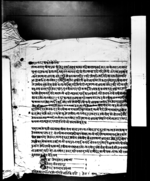A comment from the Sadara Daphtarakhānā re the appointment of Hīrānātha as abbot of the Śrīgāũ monastery (VS 1944)
ID: K_0097_0042
Edited and
translated by Christof Zotter
Created: 2019-07-17;
Last modified: 2023-11-13
For the metadata of the document, click here
The accompanying edition, translation/synopsis and/or commentary are available under the terms of the Creative Commons Attribution-ShareAlike 4.0 International License
Abstract
This is a comment of the General Registry Office (Sadara Daphtarakhānā) upon a report of Loka Bahādura Thāpā Chetrī recommending appointing Hīrānātha as successor of the late Mahanta Khimānātha on the monastic throne of Śrī Siddha Bhagavantanātha in Śrīgāũ, Salyan/Dang.Diplomatic edition
[1r]
1सदरदफदरषानालेवोलेको¯¯¯¯¯¯¯¯¯¯¯¯¯¯¯¯¯¯¯¯¯¯¯¯2सल्ल्यानादाङ्श्रीगाऊकाश्रीसिद्धभगवंतनाथकामठगद्दीमावस्न्यामहंतहरूकाचोलावदल्दामठ्ज
3गाधान्नसक्न्याचेलालाई•महंतलेकागजगरिदीपिठमाधाप्दीगद्दीसौपीजानेमहतहुन्याचे
4लालेसल्ल्यानाअडामाजाहेरगरीसोअडाकापगरिर१पट्टीसिपाहील्याईगद्दीमावसालीसल्ल्यानै•
5अडामार्फत्लालमोहरदस्षत्⟪गराई⟫दिन्यारीतअघीदेषीचलीआय़ाकोरहेछहाल्मेरागुरूषीमानाथ
6लेसावीक्वमोजीम्तीमीचेलालाईमठ्गद्दीसौपीदीञ्यूसल्ल्यानाअडामाजाहेरगरिगद्दीमावसी
7मठ्जगाचलन्गरीसनदगराउनुभनीकागज्गरीमलाईदीञाआफुमुक्तभय़ायस्अडावाटसावी
8क्वमोजीम्मलाईगद्दीमावसालीचाहीन्यासनदगराईपाउभनीमहंतहीरानाथलेनीजषीमानाथ
9कानाउकोलालमोहर•र•हजुरपाल्पाराजभय़ामागरीवक्स्याकादस्कत्नीजषीमानाथकासही[?]
10प्काकागजस्मेत्ल्याईदेषाईजाहेरगर्दासोअघीदेषीचलीआय़ाकासावीक्रीतसोसनदहरूवमो
11जीम्गद्दीमावसालीमठ्काकामकाजचलाउनलाञांसोसावीक्षीमानाथकानाउकोलालमो
12हरदस्कत्हरूकोनकल्रनीजषीमानाथकासहीछापकोमहंत्याञीगैद्दीसौंप्याकाकागज्कोन
13कल्स्मेत्गासीजाहेरगर्याकोछुसोसावीक्लालमोहरदस्कत्हरूवमोजीम्कोनीजमहंतहि
14रानाथकानाउमामहंत्याञीकालालमोहरगरीसल्ल्यानाअडामापठाइदीनुभंन्यासदरदफदर
15षानाकानाउमासनदहवस्भंनेवीन्तीचढाय़ाकोरहेछ¯¯¯¯¯¯¯¯¯¯¯¯¯¯
16
17यस्मुद्दामासोगासीचढाय़ाकाषीमानाथकानाउकालालमोहररहजुरवाटपाल्पाराजभय़ामाग
18रीवक्स्याकादस्कत्•र•नीजषीमानाथकासहीछापकोमहंत्याञीसौप्याकाकागज्स्मेत्कावे
19होराप्रमानलेर•सोसनदकागज्हरूरसावीक्वमोजीम्नीजसल्ल्यानाअडावाटस्मेत्गद्दीमाव
20सालीमठ्काकामकाजमहंत्याञीचलाउनलगाईचलाईभोगचलन्स्मेत्भैआय़ाकादेषीय़ाको
21हुनाले•सोहीसावीक्कामहंतषीमानाथकानाउकोलालमोहरवमोजीम्नीजहिरानाथका
22नाउमामहंत्याहीकोलालमोहरसनदगरीवक्सनुपर्न्याहामीहरूकाचित्तमालग्छगरीवक्स
23नुनवक्सनुजोमर्जीहुकुम्¯¯¯¯¯¯¯¯¯¯¯¯¯¯
[table1]
| 1 | [seal] | सुव्वा•सिवप्रसादउपाध्या¯¯¯¯ | १ |
| 2 | [seal] | [?]रीदारजीतवहादुर¯¯¯¯¯¯¯¯ | १ |
| 3 | [seal] | [?]रीदारवलनाथउपाध्या¯¯¯¯¯ | १ |
24इतिसम्वत१९४४सालमितीकार्तिकवदी३रोज४शुभ्म्
Translation
[1r]
Communicated by the General Registry Office (Sadara Daphtarakhānā)
The [following] petition has been made:1 "'Whenever mahantas sitting on the monastic throne of ŚrīSiddhaBhagavantanātha in Śrīgāũ, Salyan/Dang, [were about to] pass away (lit. change bodies), the mahanta would give a document (kāgaja) to a disciple who was able to manage the monastic estates, clap [him] on the back [and] confer the throne [to him]. The customary practice since earlier times has been [that] the disciple, the mahanta-to-be, informed the Salyan office (aḍḍā) and that the office's chief officer (pagarī) brought a detachment (paṭṭī) of soldiers [and] installed [the disciple] on the throne, whereafter the Salyan office had a lālamohara signed and delivered to him. In recent days my guru Khīmānātha issued a document which states: "According to custom we have conferred the throne upon you, [my] disciple. Inform the Salyan office, assume the throne, use the monastic estates [and] have a certificate of appointment (sanadapatra) issued,."2 [This] he gave to me and [later] was released (i.e. passed away). May I am receive a lālamohara, having been installed on the throne by this office according to the customary practice.' Stating this, Mahanta Hīrānātha3 brought forth and showed the lālamohara in the name of the said Khīmānātha, the daskata granted by Your (hajura) as the ruler (rāja) in Palpa4 [and] the document signed by Khīmānātha. When I was informed [about this] I—in accordance with the custom practised since earlier times and the [above-mentioned] sanadas—had [Hīrānātha] installed on the throne and brought [put in charge of] managing the maṭha. I have enclosed copies of that customary lālamohara in the name of the said Khīmānātha [and] the daskata together with a copy of the document signed by Khīmānātha [which] passed on the abbatial throne, and bring [all this] to [your] notice. May a sanada be issued in the name of the General Registry Office (Sadara Daphtarakhānā) stating: 'Issue, in accordance with the customary lālamohara, daskata etc., a mahantyāiko lālamohara in the name of the said Mahanta Hīrānātha and send [it] to the Salyan office'."
As to this trial (muddā), [we have come to following conclusion]: As proven by the details of the enclosed lālamohara in the name of Khīmānātha, the daskata issued by You as rāja in Palpa, and the paper signed by Khīmānātha [which] passed on the abbatial throne, and because we have seen that in accordance with those sanadas [and other] documents (sanada kāgajharū) and with customary [practice] the said Salyan office installed [Hīrānātha] on the throne and set him up to manage monastic affairs and the abbotship, [and that] in managing them [he] has been enjoying their fruits, it appears to us that, in accordance with the customary lālamohara in the name of Khīmānātha, a mahantyāīko lālamohara in the name of the said Hīrānātha should be issued. Whether You do so or not, whatever [Your] wish [is, will be for us an] order.
[seal] SubbāSivaprasāḍa Upādhyā - - - 1
[seal] KharīdāraJīta Bahādura - - - 1
[seal] KharīdāraBalanātha Upādhyā - - - 1
Wednesday, the 3rd of the dark fortnight of Kārttika in the [Vikrama] era year 1944 (1887 CE).5 Auspiciousness.
Commentary
A fortnight later the prime minister's Mulukī Aḍḍā concurred (see K_0097_0043), and in Māgha VS 1944 a corresponding mahantyāĩko lālamohara in the name of Hīrānātha was issued by King Pṛthvī Vīra Vikrama (see K_0469_0024).

